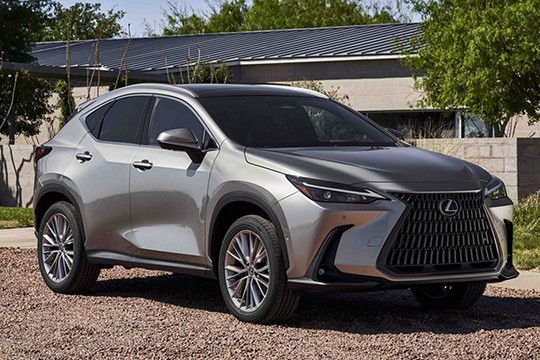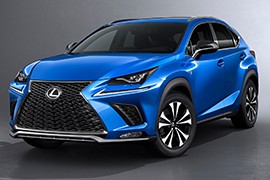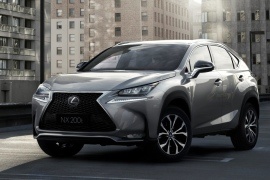LEXUS NX Models/Series Timeline, Specifications & Photos
First production year: 2014
Engines: Gasoline, Hybrid gasoline, Hybrid
Body style: SUV (Sports Utility Vehicle)
Lexus unveiled the second generation of the NX in June 2021, and despite its look very similar to its predecessor, it was a completely new vehicle from tip to toe.
The NX was the premium sibling of the Toyota Rav4, and they both shared the same TNGA-K platform with the Avalon or the Highlander models built by the same Japanese carmaker. That allowed front or all-wheel-drive systems, gasoline or hybrid power engines, and starting with the 2022 NX, a plug-in hybrid.
The 2022 NX featured a new front fascia with a more expansive "spindle-grille" design. It wasn't everybody's cup of tea, but it worked well for other vehicles within the Lexus range. It also sported new LED headlights and L-shaped daytime running lights. The door panels and fenders were a mix of curved angular lines and curved areas. At the back, the taillights featured a connecting light strip that ran across the tailgate. Its raked-forward windscreen and C-pillars enhanced the vehicle's dynamic look, while the roof spoiler created an even sportier image.
Inside, Lexus installed a 7" instrument panel named Multi Instrument Display (MID) complemented by a 10" Head Up Display (HUD) available as an option. The carmaker placed a standard 9.8" touchscreen above the center stack for the infotainment unit, with an option for a 14" display. It featured wireless connectivity with Apple CarPlay and Android Auto, enhancing the driver's experience. Lexus kept the physical turn-dials for the volume and climate control unit. The NX provided seating for four with high-bolstered front bucket seats and a bench for two in the back.
Under the hood, the compact SUV featured a range of four engines, starting with a 2.5-liter inline-four that replaced the older 2.0-liter unit and went up to a turbocharged and electrified 2.4-liter, 275 hp four-banger.
In its quest to offer more hybrid vehicles on the market, Toyota launched the NX compact SUV in 2014 at the New York Auto Show. Three years later, it came with a restyling that made the car more appealing.
Toyota had committed itself to not offer diesel engines anymore for street vehicles or light SUVs. It retained them only for the HiLux pickup-truck and for some versions of the Land Cruiser. For Lexus, it deleted that option, and for the NX installed a hybrid system.
There were not so many exterior changes to the NX. It gave the car a stronger visual impact with a number of detailed changes including a new-look spindle grille, reshaped front bumper and LED headlamp units with sequential LED turn indicators. At the rear, there were adjustments to the form and finish of the lower rear bumper and new lamp clusters. New alloy wheel designs have also been produced.
Inside, there were new color options for the NX, with the addition of Rich Cream and Ochre upholstery and trim. The tailgate received a hands-free operating system. With the key in the pocket, a foot swipe under the rear bumper would open the trunk. A similar movement would close it. A new, 10.3” Lexus infotainment system was installed, with the mouse-like control on the center console. In the instrument cluster, a 4.2 TFT LCD was installed to offer more information to the driver.
Under the hood, there was the same 2.5-liter Atkinson engine, a generator, and an electric motor. Both front and all-wheel-drive systems were available.
Lexus expanded its crossover lineup in 2014 when it introduced its compact NX as a hybrid high-rider vehicle made mostly for street use but capable enough to tackle some light off-road situations.
The Japanese premium automaker already had several SUVs in its lineup, but it needed something more affordable and perfectly adapted to the urban environment. While the RX was already known but too big to fit in smaller parking spots, a smaller vehicle was needed. So, Lexus made the NX. Its initials stood for "Nimble Crossover," and that's what Lexus tried to offer. A vehicle that provided better fuel efficiency and a similar level of comfort as its bigger sibling. But even if it was smaller, it was large enough to fit four people inside and carry enough luggage in its trunk.
On the outside, the NX followed the same aesthetic language as the facelifted version of the RX's third generation. At the front, it featured a tall spindle grille flanked by angular-shaped, narrow headlights. The lower bumper was adorned with a set of side scoops and a lower lip spoiler. From its profile, the hatchback shape of the vehicle showed a raked windshield, and a curved greenhouse ended in a raked-forward tailgate. Lexus added a roof spoiler at the back to further emphasize the car's sporty character. The automaker offered the crossover with a set of 17" light alloy wheels, and the wheel arches were adorned with black plastic trims.
Inside, the automaker tried to provide everything a premium customer wanted from a vehicle. As a result, the leather upholstery was on the menu, but the entry trim level featured fabric upholstery, depending on the market. Between the high-mounted front seats, the automaker installed a center console that housed the touchpad for the infotainment system. The driver fronted an instrument cluster filled with two large dials for the speedometer and tachometer and flanked by the fuel and temperature gauges. In the middle, Lexus installed a small color display for additional info provided by the onboard computer. On top of the center stack, in a free-floating position, the NX featured a 6.2" screen for the infotainment system. In the back, the automaker installed a flat bench fit for three adults, with a very small bump on the floor for the center tunnel.
Toyota chose two engine versions to power the compact-sized premium crossover. The base version featured a two-liter turbocharged inline-four that drove the front wheels only via a six-speed automatic transmission. In addition, an all-wheel-drive version was available. For those looking for cleaner emissions, Lexus offered a hybrid model powered by a 2.5-liter gasoline engine that ran in the Atkinson cycle paired with an eCVT gearbox that sent power to the front or in all corners, depending on the options.


